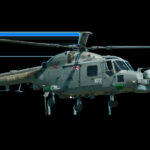Every summer, a peculiar event occurs that often catches us by surprise: the sudden appearance of winged ants. One moment the ground seems clear, and the next, it’s teeming with these larger insects. They fill the air, causing us to instinctively duck and weave to avoid them. This raises a common question: Can Ants Fly? And what exactly causes this mass exodus into the sky? Let’s delve into the world of flying ants to understand when and why these creatures develop wings and take to the air en masse.
Understanding Flying Ants: The Alates
The flying ants we witness are scientifically known as alates. In the UK, and especially in urban settings, these winged insects are almost exclusively the sexually mature queens and males of the black garden ant, Lasius niger. Distinguishing them is quite straightforward: the larger ones are the queens, impressively reaching up to 15mm in length.
Black garden ant (Lasius niger) alates on a building. The queens are noticeably larger than the worker ants.
When Does Flying Ant Season Occur?
This annual spectacle, often referred to as “flying ant day,” typically happens during July or August, perfectly timed with spells of hot and humid weather. However, it’s crucial to understand that flying ant appearances vary across the country, heavily influenced by local weather patterns which are key to synchronizing their swarming behavior.
Interestingly, ants in urban areas tend to take flight earlier than their rural counterparts. This is likely due to the ‘urban heat island effect,’ where cities retain more warmth, leading to earlier temperature increases.
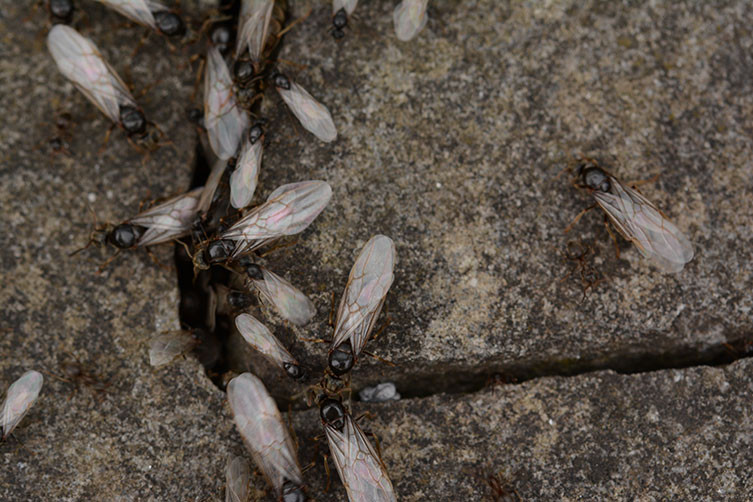 Winged ants about to fly
Winged ants about to fly
The timing can sometimes be quite disruptive, even impacting major events like Wimbledon. There have been years where flying ants have plagued tennis players, causing such significant interruptions that it made headlines. While these swarms are most common between June and early September, the idea of a single “flying ant day” is actually a misconception.
Research from a Royal Society of Biology citizen science project has debunked the myth of a singular ‘flying ant day’. Instead, it’s more accurately described as a ‘flying ant season.’ Winged ants emerge over several weeks, with multiple peak periods, each lasting just a few days. The exact pattern of these swarms changes from year to year, dictated by weather conditions.
Weather is the primary trigger for swarming. Studies have shown that ants fly only on warm, windless days, particularly when conditions are an improvement from the previous day. There’s also common observation suggesting that flying ant swarms often follow summer rainfall.
The Origin of Flying Ants: From Underground Nests
Before they take to the skies, these flying ants lead ordinary lives within their colonies, nestled underground. Black garden ants prefer to nest in dry soil, commonly found in flower beds, lawns, and beneath paving slabs or stones, with patios being a particularly favored location. They thrive in almost any dry, sun-warmed area, including gardens, pavements, brownfield sites, heathland, grassland, and coastal regions.
In the weeks leading up to the swarming event, you might notice small mounds of soil appearing above their nests, a subtle sign of the activity beneath.
 Exposed ant nestLasius niger ant nest showing worker ants and pupae after a paving slab was moved.
Exposed ant nestLasius niger ant nest showing worker ants and pupae after a paving slab was moved.
Ant colonies operate under a caste system, where each ant has a specific role. The queen’s primary duty is to lay eggs, while female worker ants care for the queen, eggs, and larvae. They also handle food collection, nest expansion, and overall colony maintenance. Most eggs develop into workers, but when the colony reaches maturity, the queen starts producing virgin queens and males.
When these winged males (drones) and virgin queens (princesses) emerge, they disperse widely. This scattering is crucial for maximizing mating opportunities between different colonies and minimizing inbreeding.
The Purpose of Flight: The Nuptial Flight
Ant colonies have limited expansion capabilities. Eventually, a new queen must venture out to establish her own colony. This requires mating with a male from a different colony and finding a suitable new location to build a nest. Developing wings and flying is their solution to achieve this.
Each year, alates emerge from their nests for this purpose. They aren’t interested in humans or picnics; their sole mission is to find a mate. The sight of large winged females and smaller winged males flying together is common – this is known as the nuptial flight.
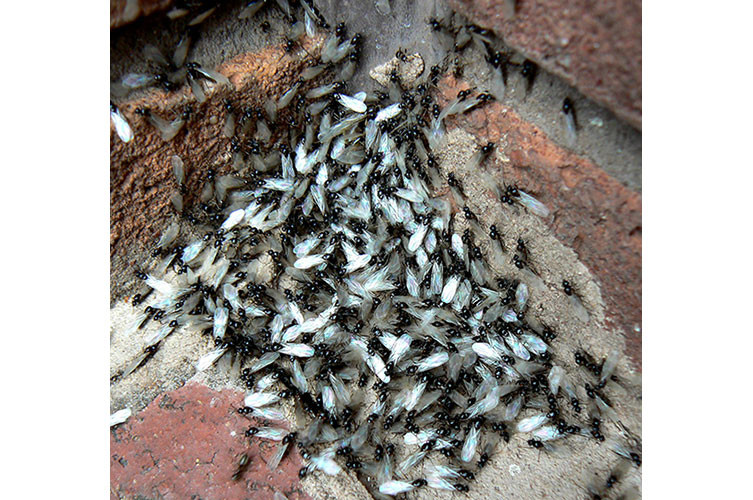 Lots of winged ants in a corner between bricks
Lots of winged ants in a corner between bricks
Swarming Behavior: Safety and Reproduction in Numbers
The question arises: why do flying ants appear in such vast numbers, seemingly all at once? One key reason is predator protection. There’s genuine safety in overwhelming numbers. By swarming, they minimize individual risk of predation.
Another critical reason for swarming is to boost reproductive success. With a massive number of their species present, the ants don’t need to search far to find a mate, ensuring efficient reproduction. During this brief, once-in-a-lifetime mating window, a queen typically mates with multiple males, securing enough sperm for her entire reproductive life.
Life After the Nuptial Flight
Once mating is complete, the males’ purpose is fulfilled. The newly mated queens quickly chew off their wings and begin their search for a suitable nesting site to establish a new colony. This explains why you often see larger, wingless ants walking around after a “flying ant day,” and you might even spot discarded wings scattered on pavements.
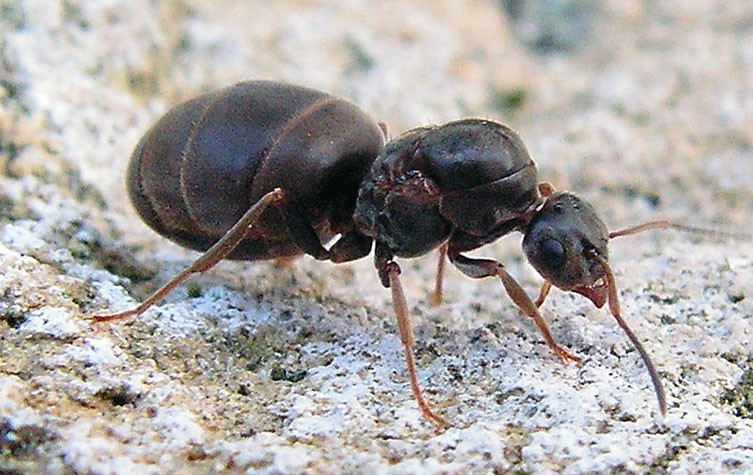 A queen ant that no longer has wingsLasius niger queen that has chewed off her wings after successfully mating.
A queen ant that no longer has wingsLasius niger queen that has chewed off her wings after successfully mating.
The ants we usually see throughout the year are female workers, diligently foraging for food for the colony. After finding a suitable location, the queen digs an underground chamber and lays her first eggs, nurturing them to adulthood. Remarkably, she will not eat for weeks until her first generation of daughter worker ants are ready to gather food for her.
The sperm she received during the nuptial flight will sustain her egg fertilization for the rest of her life, which can be many years. Queens often reproduce until their colonies grow to thousands, sometimes exceeding 20,000 workers in large nests.
Lifespan of Flying Ants
Male flying ants have a short lifespan. They perform no work in the nest and are only produced by the colony during the flying ant season, developing from unfertilized eggs. After the nuptial flight, males typically live for only another day or two, their entire adult life barely exceeding a week. Their sole purpose is reproduction.
In contrast, Lasius niger queens are incredibly long-lived, with a general lifespan of up to 15 years, and some in captivity have even reached 28 years. However, their time as winged or flying ants is a brief phase early in their lives, dedicated to establishing new colonies.
The Unexpected Benefits of Flying Ants
While flying ants can be a nuisance to some, their activities are actually beneficial to the ecosystem. Their tunneling improves soil quality through aeration and nutrient distribution.
Furthermore, these swarming events are a crucial food source for many bird species. Swifts and gulls are frequently observed feasting on swarming ants.
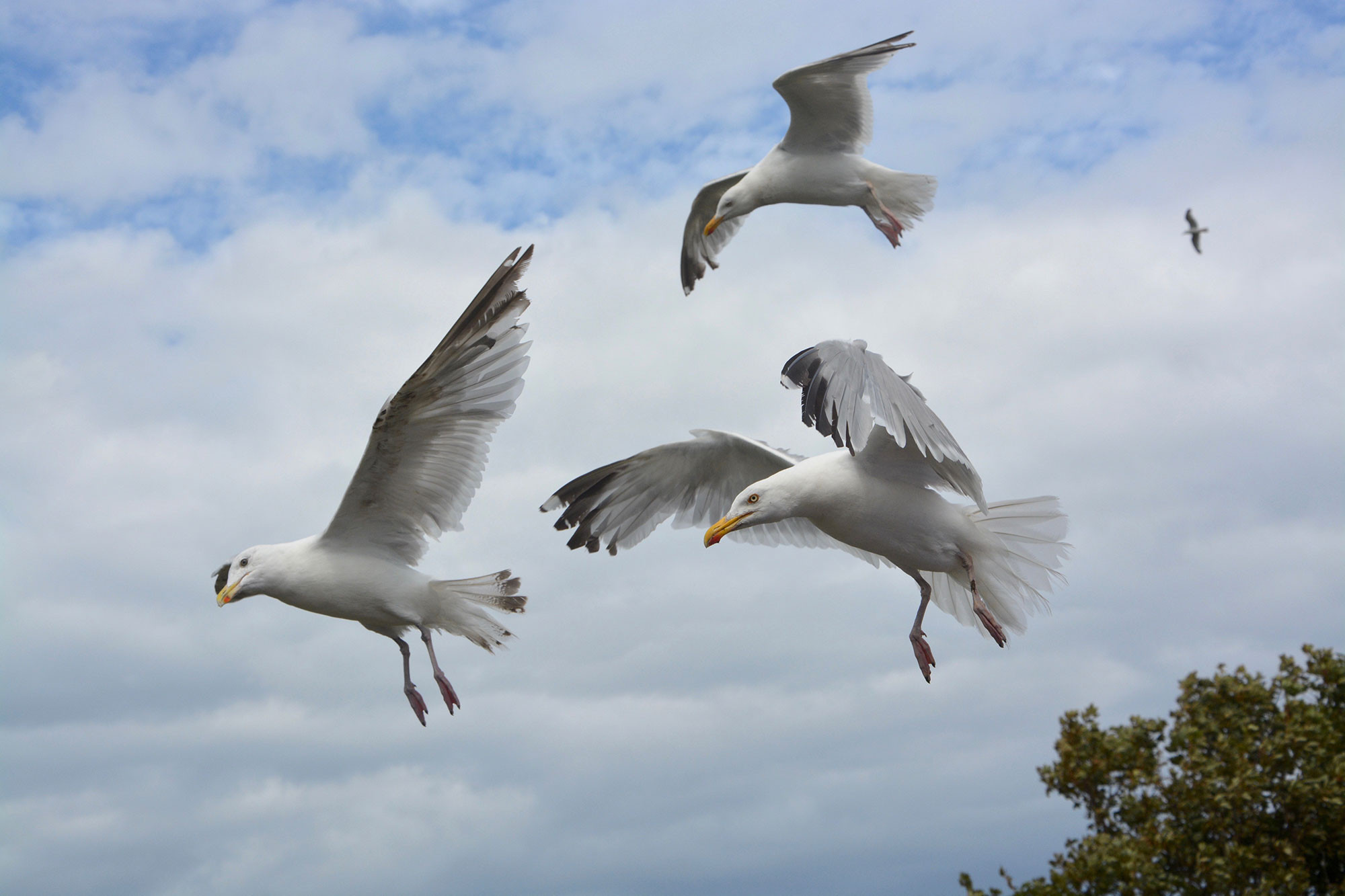 Three flying seagulls
Three flying seagulls
Black garden ants, along with cornfield ants (Lasius alienus), are especially vital for the survival of the silver-studded blue butterfly (Plebejus argus) in heathlands. This butterfly species has faced population declines across much of its habitat.
The ants and the butterfly share a mutually beneficial relationship. The ants protect the butterfly caterpillars from predators, and in return, they feed on secretions produced by the caterpillars.
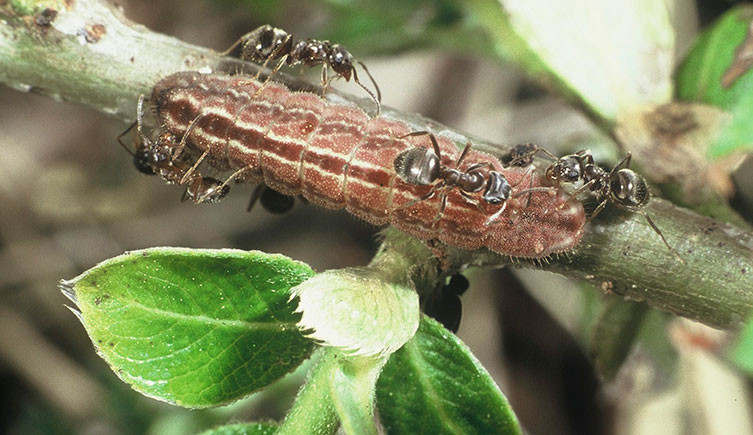 A few ants on a Plebejus argus caterpillarPlebejus argus) caterpillar in exchange for nutritious secretions.
A few ants on a Plebejus argus caterpillarPlebejus argus) caterpillar in exchange for nutritious secretions.
Ant Diversity in the UK and Red Flying Ants
Ants, along with bees and wasps, belong to the Hymenoptera insect group, easily identified by their three distinct body parts. The UK is home to approximately 60 ant species, all living in complex colonies.
While black garden ants are the most commonly observed flying ants, other species also participate in nuptial flights. Red ants (Myrmica rubra) are another common British ant species that develop wings and swarm. However, surveys by the Royal Society of Biology indicate that nearly 90% of winged ants observed are black garden ants (Lasius niger), also known as common black ants.
 Winged Myrmica rubra antMyrmica rubra, a common red ant found in Britain.
Winged Myrmica rubra antMyrmica rubra, a common red ant found in Britain.
The types of flying ants you encounter will depend on your location. For instance, woodland areas might see wood ants taking flight. Regardless of species, all flying ants require favorable weather conditions – warm temperatures, no rain, and minimal wind. The specific temperature and humidity levels that trigger swarming and flight differ for each species, leading to variations in the timing of their nuptial flights throughout the season.
